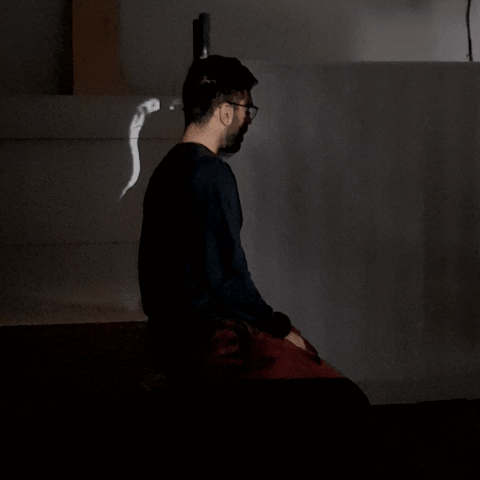‘Remnant of affection’ is a typology machine that explores the thermal footprint of our affective interactions with other beings and spaces.
For this study, I have focused on one of the most universal shows of affection: a hug. Polite, intimate, or comforting; passionate, light, or quick; one-sided, from the back, or while dancing. Hugs have been widely explored compositionally from the perspective of an external viewer, or from the personal description of the subjects that intervene in its performance (‘Intimacy Machine‘ Dan Chen, 2013). In contrast, this machine explores affection in the very same place where it happens: the surface of its interaction. Echoing James J. Gibson, the action of the world is on the surface of the matter, the intermediate layer between two different mediums. Apart from a momentaneous interchange of pressure, a hug is also a heat transfer that leaves a hot remnant on the surface once hugged. Using a thermal camera, I have been able to see the radiant heat from the contact surface that shaped the hug and reconstruct a 3d model of it.
The Typology Machine
Reconstructing the thermal interchange of a hug required a fixed background studio setting due to the light conditions and the unwieldy camera framework needed for a photogrammetry workflow. After dropping the use of mannequins as ‘uncanny’ subjects of interaction in the Lighting Room at Purnell Center, the experiment was performed on the second floor of the CodeLab at MMCH.



First, I asked a different couple of volunteers if they would like to take part in the experiment. Although a hug is bidirectional, one of the individuals had to take the role of the ‘hugger,’ standing aside from the capture, while the other played the role of ‘hug’ retainer. The second one had to wear their coat to mask their own heat and allow more contrasted retention of the thermal footprint (coats normally contains normally synthetic materials, such as polyester, with a higher thermal effusivity that stores a greater thermal load in a dynamic thermal process). Immediately after the hug, I took several pictures of the interaction with two cameras at the same time: a normal color DSLR with a fixed lens, and a thermal camera (Axis Q19-E). Both were able to be connected to my laptop through USB and Ethernet connection, so I could use an external monitor to visualize the image in real-time and store the files directly on my computer.

Camera alignment
One of the big challenges of the experiment was to calibrate both cameras so the texture of the thermal image could be placed on top of the high-resolution DSLR photograph. To solve this problem, I used an OpenCV’s circles grid pattern laser cut onto an acrylic sheet that showed every circle as a black shadow for the normal camera, and simultaneously, placed on top of an old LCD screen with a lot of heat radiation, showed every circle as a hot point for the thermal camera.

After that, the OpenCV algorithm finds the center of those circles and calculates the homography matrix to transform one image into the other.
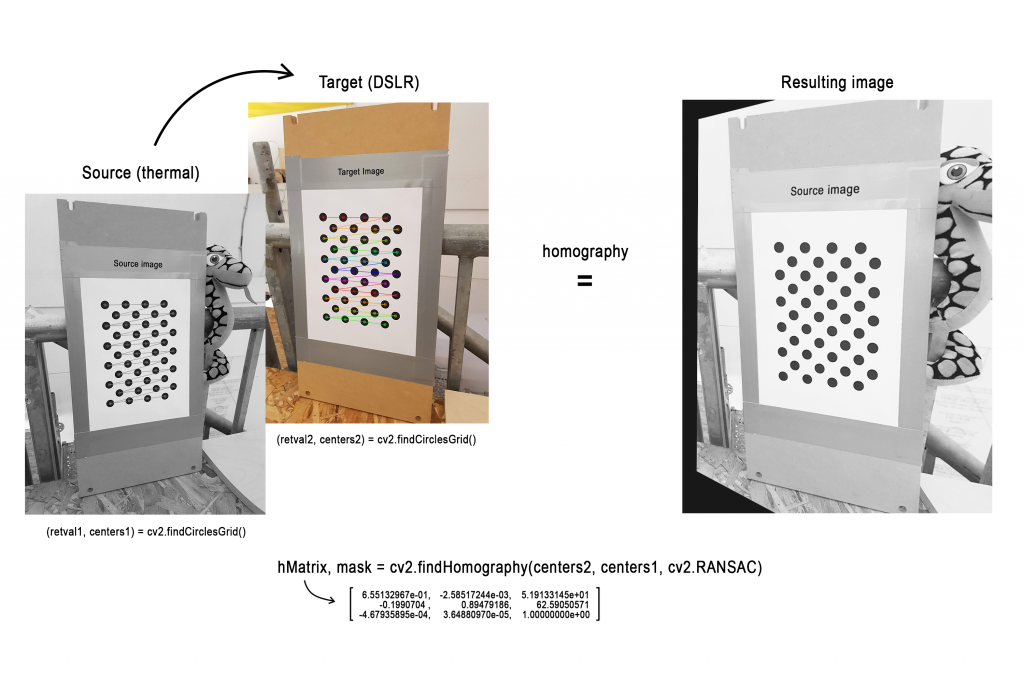
The subsequent captured images were transformed using the same homography transformation. The code in Python to perform this camera alignment can be found here.
Machine workflow
The typology machine was ultimately constituted by me. Since the Lazy Susan was not motorized, I had to spin the subject to obtain a series of around 30 color and thermal images per hug.
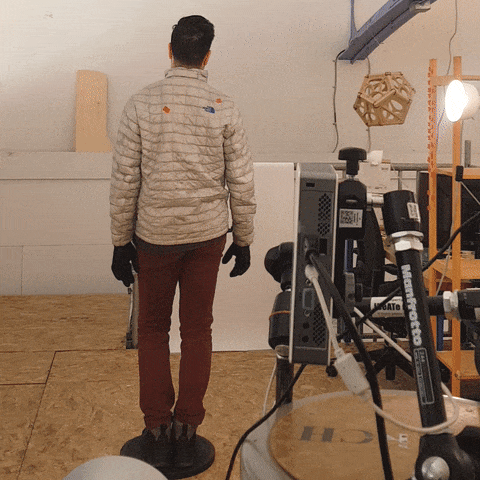
I also had to placed little pieces of red tape in the subject’s clothes to improve the performance of the photogrammetry software to build a mesh of the subject out from the color images (the tape is invisible for the thermal camera).


Thermogrammetry 3d reconstruction
Based on the principles of photogrammetry and using Agisoft Metashape, I finally built a 3d model of the hug. Following Claire Hentschker‘s steps, I built a mesh of the hugged person.
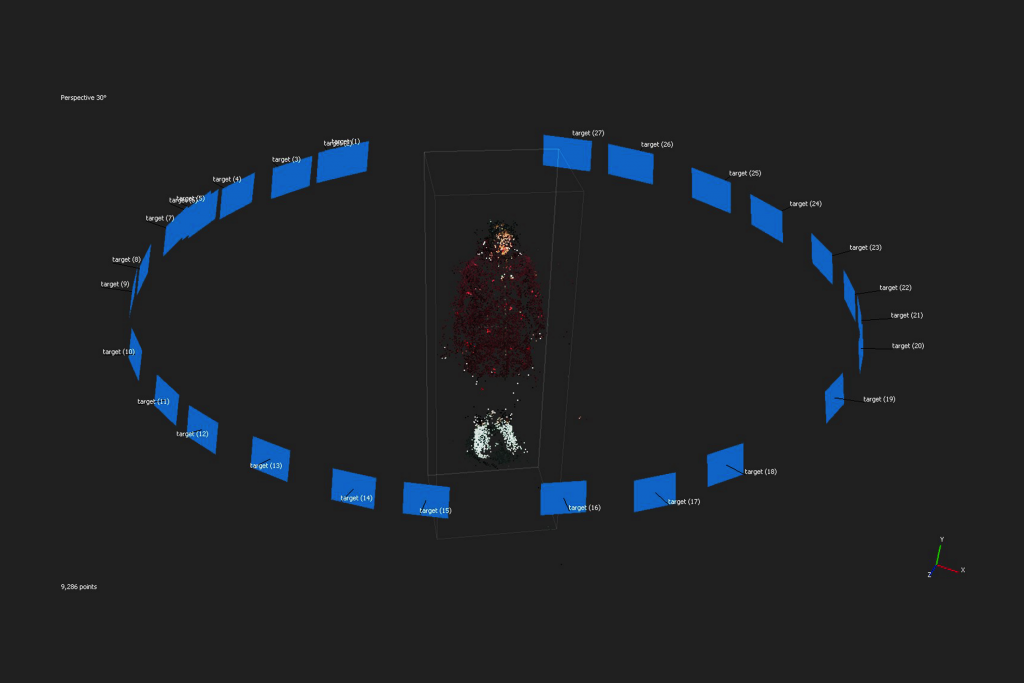
Since the thermal images have not features enough to be used by the software to build a comprehensible texture I used first the color images for this task. Then, I replaced the color images with the thermal ones and reconstruct the texture of the model using the same UV distribution of the color images.
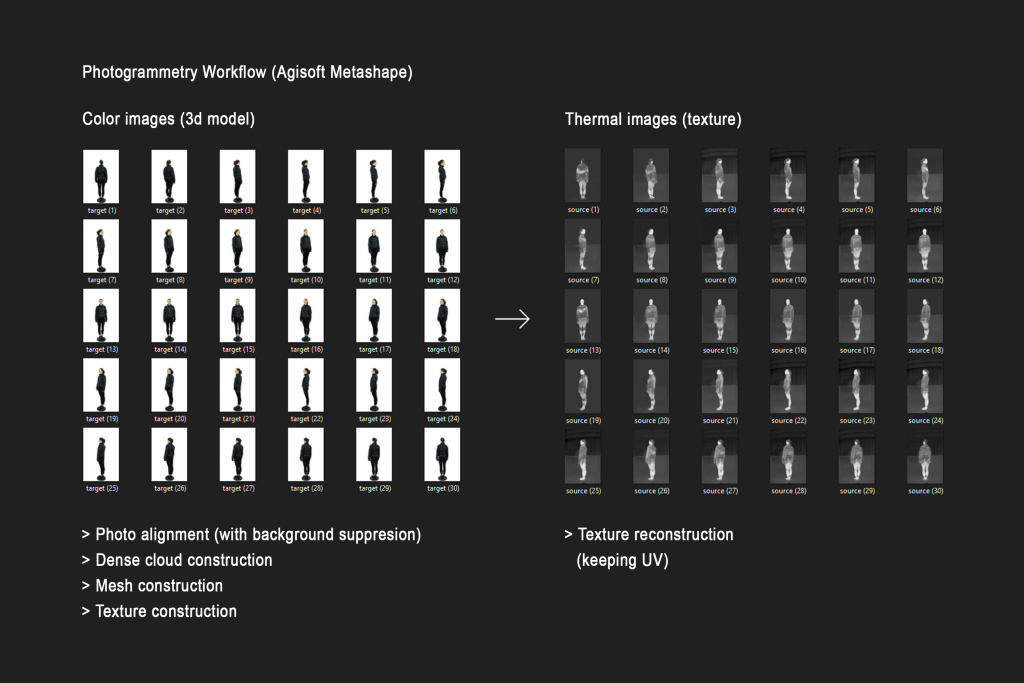
Finally, the final reconstruction of each hug is processed to enhance the contrast of the hug in the overall image with Premiere and Cinema 4D. Here the typology:
A real-time machine
My initial approach to visualize the remnant heat of human interaction was to project on top of the very same surface of the subject a thresholded image of the heat footprint. The video signal was processed using an IP camera filter that transformed the IP streaming into a Webcam video signal, and TouchDesigner, to reshape the image and edit the colors.

Initially, that involved the use of a mannequin to extract a neat heat boundary. Although I did not use this setting at the end due to the disturbance that provokes to hug an inanimate object, I discovered new affordances to explore thermal mapping.
I hope to explore this technique further in the future.
